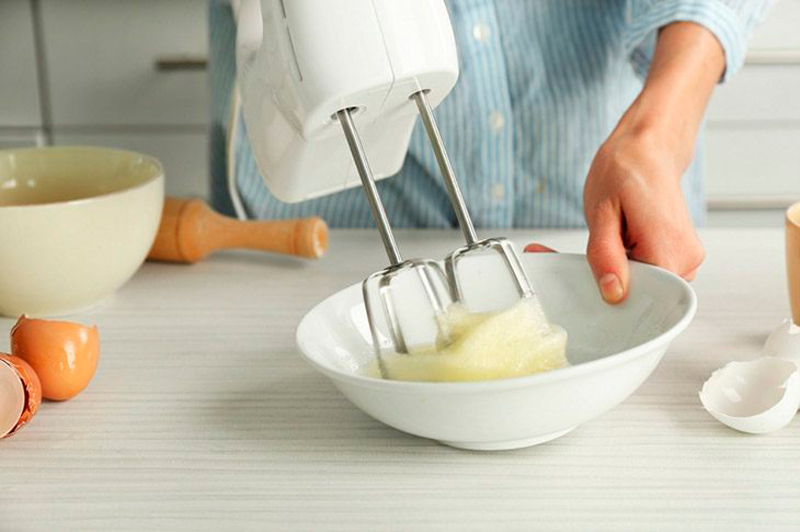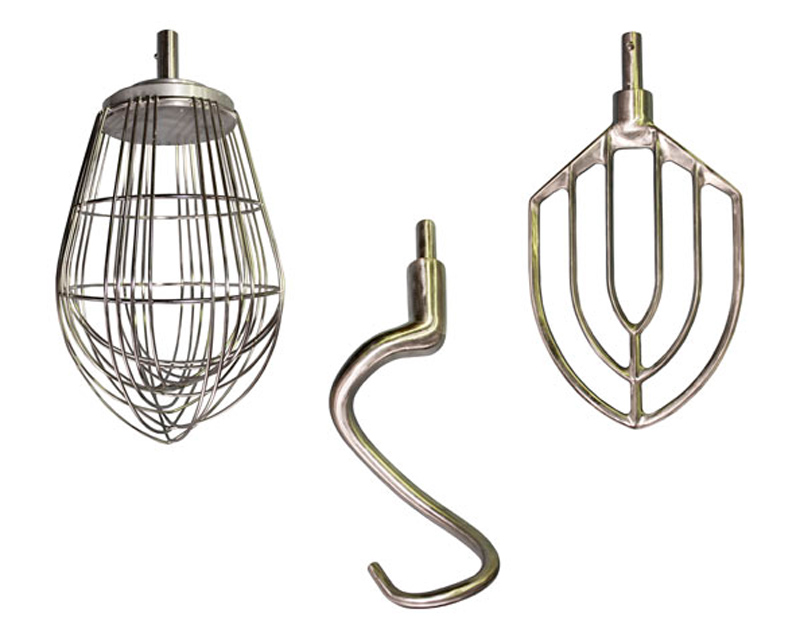A good mixer can greatly simplify the life of both an avid chef and an omelet lover. The main thing is to arm yourself with the device that is right for your lifestyle, culinary ambitions and budget. In this article we will tell you how and which mixer to choose for your home, in which case the blender should prefer the mixer and why the stationary model is better than manual.
What to choose - a mixer or blender?
The main difference between these devices consists in different functions:
- The purpose of the blender is to grind the product with knives, and the purpose of the mixer is to whisk with a whisk, as well as kneading dough with a hook. A mixer can not make cream soups, baby food, smoothies and cocktails, chop nuts, and a blender can turn cream into foam or knead yeast dough.
But since the immersion blender always has an additional nozzle in the form of a whisk and sometimes even a hook for kneading dough, the question arises - can the blender replace the mixer? Yes, but only in part.
- The fact is that the blender is comparable in its capabilities only with a hand mixer, but not with a stationary mixer. After all, only a stationary device is able to quickly and accurately knead a thick and dense dough, say, for pies and dumplings. Neither the blender nor the hand mixer will cope with this task.
But with such non-trivial tasks as beating eggs or pancake dough, the blender will cope almost as well as the hand mixer (but the mixer is still more efficient and more convenient for long-term work). If you like the idea of 3-in-1 devices, then we advise you to choose either a submersible blender with a capacity of 500 W and a hook included, or ... as much as possible a powerful blender mixer that looks like a mixer, but has a chopper head. You can learn other nuances of choosing a blender in our step-by-step guide (see the material: Guide to the choice of blender submersible and stationary type). And this video will help you not only understand the difference between two similar devices, but also choose a mixer for the kitchen.
6 steps to choose
Step 1. Determine the type of mixer
Mixers are conventionally divided into three categories: manual, stationary and stationary with a planetary mixing system.
- Hand Mixer - light and low-power (200-500 W) device with two corollas and two hooks in the kit. Great for whipping eggs, cream, butter, as well as for kneading semi-liquid dough, for example, for sponge cake or fritters. It is good because it is inexpensive (from 500-3000 rubles), takes up little space, is easy to clean (just remove and rinse the nozzles) and allows you to comfortably beat very small portions. Unfortunately, the power of the handheld device is not enough to knead the yeast dough for pies or steep dough for ravioli, dumplings and mantas. However, if you cook these dishes rarely, then a hand mixer is an excellent choice.

- Stationary mixer (household type) - It is a stationary device with a bowl, stand and mixer, all with the same beaters and hooks. Thanks to this device, the device can handle the product without your participation.All you need to do is load the bowl with ingredients and start the engine. Since in modern stationary mixers, not only the nozzles, but also the bowl itself rotate, the mixture is processed evenly. In addition, due to the higher power (400-700 W), such a mixer is able to knead even steep dough. If necessary, the mixer can be removed from the stand and used as a normal hand-held device. Disadvantages: high price compared to manual (average price of 2500-8000 rubles), larger size, greater engine noise and thicket rotation. Also inconvenience can be called the need to wash the bowl before processing the next product, while the hand mixer requires only cleaning the nozzles. Compared to a planetary mixer, a standard device costs much less, but it is less stable, its engine is much less durable and reliable. Who is the stationary household mixer for? To all those who not only beat eggs and sponge dough, but also prepare flour products from thick or yeast dough. But it does not do it daily, but only from time to time.
- Planetary mixer - this is the same stationary mixer, but more powerful (500-1200 W), and most importantly - with a nozzle rotating on the principle of rotation of the planet, that is, around its axis and at the same time around the entire circumference of the bowl. Thanks to this “focus” it turns out to achieve the perfect quality of the mixture in the shortest possible time. If you cook frequently and in many ways (especially cakes, sweets, pies, dumplings), then the planetary mixer will become the most demanded “workhorse”. By the way, some models of planetary mixers have another bonus - the possibility of equipping with additional devices: a meat grinder, a grater, a dough and noodles-rolling, a grinder and even a juicer. Such multifunctional mixers are often called food processors or kitchen machines. The disadvantages of planetary mixers include, first of all, the high price (from 5 tr to 130 tr.), A lot of weight and noise.

To better understand the difference between the three types of mixers, we recommend that you familiarize yourself with the following video review.
Step 2. Pay attention to power
When choosing a mixer, the first thing you need to pay attention to is power. As a rule, in many respects it depends on her performance and processing speed of products. The more power, the more dough can knead the device. At the same time, the more powerful it is, the higher its cost and the more electricity it consumes.
- For a hand mixer, which only beat / knead the liquid and semi-liquid mixture, the power of 250 W is enough. If you use a hand mixer often and for a long time (more than 10 minutes), then choose a mixer more effectively - 350-400 watts.
- Power stationary mixer for domestic use should be at least 500 watts.
- It is advisable to purchase a planetary mixer for occasional use with a power of at least 600 W, for an everyday one - at least 900 W.
Step 3. We look at the materials of the body and bowl
Low-cost stationary mixer housings are most often made of plastic, while models are more expensive and planetary mixers are made of stainless steel.
- Steel cases of stationary mixers are more stable due to their gravity, which is especially important when mixing dense dough. In addition, they are much more beautiful and durable. However, metal mixers are much more expensive than similar devices in plastic.
- Plastic cases with heavy loads often begin to smell, creak and shake. But they greatly reduce the cost of the device and they are easier to transport, move from place to place.
Mixer bowls are plastic, glass and metal.
- Glass bowls are eco-friendly, inexpensive, beautiful, but fragile. Plastic thickets do not fight and are inexpensive, but can deform over time and change color. The ideal material for the bowl is stainless steel.
Step 4. Select the volume of the bowl
Mixers are completed with bowls from 1.5 to 6 liters.From this indicator depends on what the maximum amount of product you can beat / mix at a time. But there are no minimum limits for stationary mixers - even in the largest bowl, you can beat a couple of eggs or a dozen equally well. The secret of this ability lies in the same planetary mixing system or in the rotation not only of the nozzle, but also of the bowl.
To determine the volume of the bowl, think about what maximum volumes you usually process in a mixer and add 200-500 ml to this number. This stock will not allow the mixture to splash, and flour and sugar - to crumble out of the bowl.
Speaking of spraying. When buying a mixer, be sure to attach a special lid with a hole to add ingredients. This simple object will protect your kitchen from stains and at the same time allow you to pour and pour everything you need right during the work process. Unfortunately, inexpensive blenders are often not equipped with such a lid.
And a couple of useful tips for choosing the bowl:
- When choosing mixers in a store, try testing their bowls, simulating, say, pouring biscuit dough into a mold. The handle of the bowl must be such that you can hold the container with one hand and easily scrap the contents of the bowl with the other hand with a spatula. The bowl itself should be easily removed from the stand.
- It makes sense to buy an extra bowl so that when cooking multicomponent dishes you don’t have to wash an already used container once again.
Step 5. Select the nozzles and accessories
Most often the stationary mixer is completed with only a couple of nozzles - a whisk for beating and a hook for kneading tough dough. Moreover, the hook can really be a hook as in the photo below (for kneading a dense dough) or spiral-shaped (for a more liquid dough). Sometimes the kit includes a paddle for mixing the batter. Some mixers have a nozzle for mashed potatoes and / or a chopper head (blender) for making sauces, smoothies, cocktails, etc.

Standard set of nozzles for a planetary mixer
Mixers, combines, as we have noted earlier, can be equipped with additional nozzles: meat grinder, testorakskatkoy, citrus press and grater. Sometimes these tips are included, and sometimes they are purchased separately.
Step 6. We learn about modes, speeds and additional options.
Mixers work in 3 modes:
- Standard - the device simply turns on, starts to beat or mix.
- Pulsed - the motor operates in pulses, like jerks. This mode is more suitable for grinding (!) Solid products, rather than beating and mixing.
- Turbo mode - in this mode, the mixer works rapidly, but for only a few seconds, in order to avoid overheating of the engine.
The rotation speeds of the nozzles are available for mixers from 3 to 20. The more speeds the device has, the thinner you can adjust the degree of product processing, smoothly slow down or speed up the rotation of the nozzles.
- However, as practice shows, most chefs have enough 3-5 speeds.
Of the really useful additional options can be identified:
- The timer that allows you to set the desired on and off time, which is very convenient when you need to leave.
- A protective system that automatically turns off the mixer when there is a risk of overheating.
Finally, for those who decide to choose a planetary mixer, we offer you to familiarize yourself with the following video review of the KitchenAid mixer in comparison with a food processor.
- Multivark selection guide
- How to choose the perfect coffee machine
- Juicer Step-by-Step Guide
- 6 factors you need to know before buying a microwave
- How to choose a dishwasher - getting ready to buy



 (Rate the material! Already voted:20 average rating: 4,15 from 5)
(Rate the material! Already voted:20 average rating: 4,15 from 5)